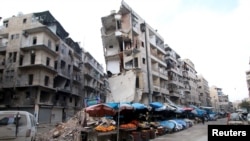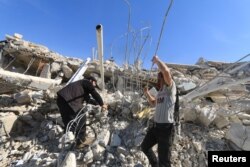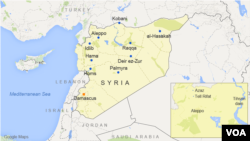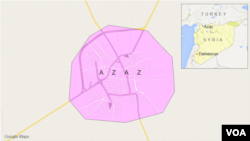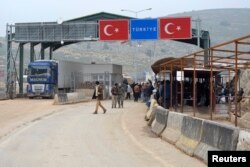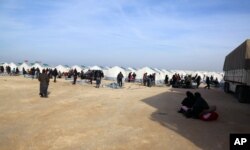There is growing concern about the fate of thousands of Syrians working inside the war-shattered country for Western non-profits or on development and governance projects funded by U.S. agencies and European governments.
Western officials fear they will be targeted by the Assad regime as a government offensive continues to grab back more towns and territory from the rebels. And behind-the-scenes, officials are urging Turkey to admit Syrian NGO workers and political activists who want to flee, say several diplomats and aid agencies contacted by VOA.
So far less than two dozen “political exceptions” have been admitted by the Turks through northern Syria’s Bab al-Samah border crossing, just a few kilometers from advancing government-aligned militias and near to a hospital that was hit earlier this week in a government airstrike.
6,000 Syrians at immediate risk
Immediate concerns are focused on about 6,000 Syrians — a number that includes Syrian contract employees for Western NGOs, as well as family members and dependents.
“There are huge worries about their fate,” a British official told VOA. “The danger should not be underestimated.”
Bassam al-Kuwaiti, a Syrian political activist based in Turkey, warned they will be “targeted by the regime and Russian troops.”
NGO workers, political activists face harsh treatment
Throughout the five-year conflict, and before the uprising, the Assad government has treated NGO workers and political activists harshly.
A 2014 U.S. State Department Human Rights report noted Syria had “detained tens of thousands of individuals associated with nongovernmental organizations, human rights activists, journalists, humanitarian aid providers, and doctors without access to fair trial,” using “rape and assault as punishment.”
When it comes to NGO workers, the regime has targeted especially those working on civil society and democracy issues.
Last week, a U.N.-backed commission of inquiry reported that thousands of Syrians are disappearing and dying in government detention centers on a scale that amounts to state-sponsored “extermination.” The report gave harrowing details of detainees who have died as a result of torture or inhumane treatment in detention centers run by the Syrian government’s intelligence agencies.
Network of councils targeted
Aside from Syrians who are working for Western non-profits, there is also rising alarm about what may befall Western-friendly political activists who have built-up a network of councils in rebel-held districts.
Across parts of rebel-controlled Syria, 416 local councils were functioning before this month’s Russian-backed government offensive unfolded in rural Aleppo.
In some towns, council officials were elected in rudimentary-run polls. Many of the councils in Aleppo, rural Idlib, Latakia and in rebel-controlled towns ringing Damascus, originated as local relief efforts. But they developed quickly thanks to grassroots efforts and Western funding.
Last October, Deputy U.S. Secretary of State Tony Blinken announced Washington was giving another $100 million to the moderate Syrian opposition, some of which was earmarked for local governments inside rebel-controlled Syria.
Western officials viewed the councils' emergence as a civic breakthrough, hoping it would help nudge the ideological direction of the rebellion, temper sectarianism and curtail radical Islamists. And councils have often had to navigate Islamist disapproval or cope with the threat of violence.
Multiple dangers
The danger for councilors in the coming weeks may not only come from the government as it grabs back more territory, worry Western officials and the councilors themselves.
In the aftermath of the devastating Assad offensive a realignment of rebel militias is already under way, boosting the power of hardline Islamist militias and al-Qaida affiliate Jabhat al-Nusra, which has frowned on the council’s activities.
“If Jabhat al-Nusra and allied Islamists start to grow in power there will be real risks for the councilors,” said Mazen Gharibah of the Local Administration Councils Unit, which advises the local councils. “They are already trying to take over the councils with their Higher Islamic Committees,” he added. There are some councilors in Aleppo trying to get out now, he said.
Getting out
Some councilors are among the tens of thousands of displaced civilians sheltering by the border near the crossing at Bab al- Samah. Satellite imagery released Thursday by Human Rights Watch demonstrates the massive influx of civilians by the border.
Estimates vary on how many displaced civilians there are — some have taken refuge in the nearby town of Azaz or are spread out in nearby fields and small settlements close to the border, which makes an accurate head-count difficult.
Some civilians are heading for the neighboring province of Idlib, hoping they will have a better chance to cross the border near the crossing at Bab al-Hawa.
The United Nations estimates there are 70,000 refugees around Bab al-Samah and Azaz, but relief workers said the number may be closer to 100,000.
But being huddled by the border isn’t relieving the anxiety of displaced civilians. Relief workers describe a sense of panic — one that has spread also to rebel fighters, who want to get their families out of Syria and to safety in Turkey.
“Syrians fleeing bombing in the Azaz enclave aren’t even safe in the places they’ve sought shelter, but there are so few places for them to go,” warned Nadim Houry of Human Rights Watch.
While Turkish authorities are not allowing civilians to pass through the border with Syria, they permitted midweek several hundred mainly Islamist rebel fighters to enter Turkey from Syria’s Idlib province, pass through Turkish territory and re-enter the northern Aleppo countryside via Bab al-Samah, say rebel commanders.
The Syrian Observatory for Human Rights, a pro-opposition monitoring network of activists, says one group transferred over on February 15. Rebel commanders say another group on Wednesday. Most fighters headed for Azaz.




